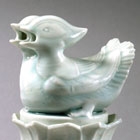J.J. Lally & Co., Oriental Art / New York City, New York
MenuPast Exhibition
Chinese Porcelain and Silver in the Song Dynasty
March 18 - April 8, 2002
21.
A YINGQING PORCELAIN 'MANDARIN DUCKS'
INCENSE BURNER
Song Dynasty, A.D. 11th/12th Century
hollow-moulded with a pair of mandarin ducks on top of the disc-shaped cover, the birds shown snuggled close together with their necks entwined and their beaks wide open, hollowed through to a large aperture on the interior to allow the incense smoke to escape, the base moulded in the form of a lotus bud with overlapping petals around the deep sides rising to a flared rim of pointed petal tips enclosing a recessed lip to receive the cover, with two circular vent holes through the sides below the rim and raised on a wide stem and a waisted circular base, the translucent glaze of bright aquamarine tone where it pools in some recessed areas and thinning to a much paler tone over the raised areas to highlight the details, the underside of the cover and base unglazed, exposing the fine white porcellaneous ware, with dark iron-brown marks left from the kiln supports.
Height 5 7⁄8 inches (15 cm)
A closely related Yingqing censer with a single mandarin duck hollow-moulded as the cover, on a larger and more elaborate lotus-petal bowl and dish-form base is illustrated on the cover of the catalogue of the exhibition which toured Japan in 1989, entitled Masterpieces of Chinese Arts from The Art Institute of Chicago, no. 72 also illustrated on p. 85, and illustrated again by Pearlstein and Ulak in Asian Art in The Art Institute of Chicago, Chicago, 1993, p.60.
Compare also the Yaozhou celadon censer of closely related form also with a single hollow-moulded duck for the cover and with a lotus-pod and pedestal base, illustrated by Ayers in The Seligman Collection of Oriental Art, Vol. II, Chinese and Korean Pottery and Porcelain, no. D144, described on p. 75, where the author suggests that the design might be derived from Korean prototypes.
